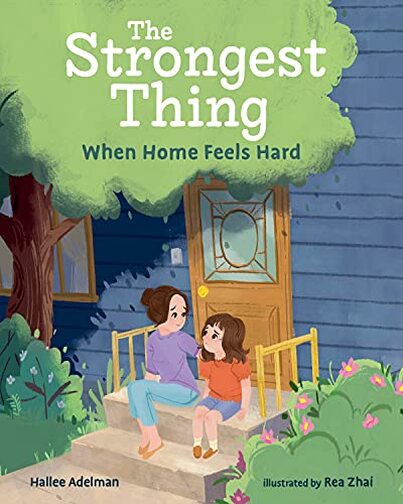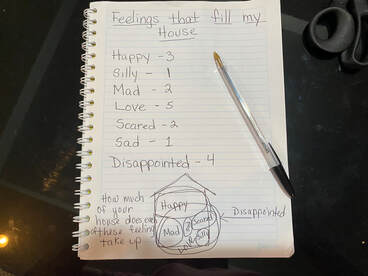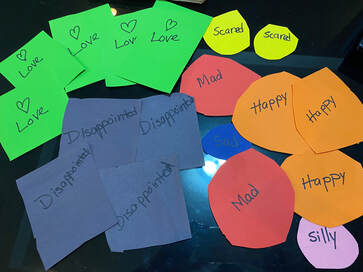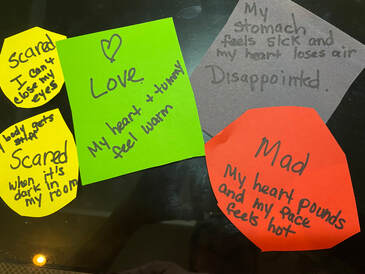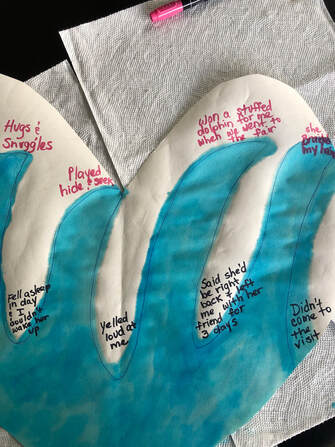A Book Review of The Strongest Thing
The book features a young girl, Sera, who finds her home a hard place to be due to her Dad's problems with anger control. He raises his voice and blames his family for things in which they have no control. At the height of his anger, he leaves the house and slams the door so hard, that the glass breaks. This is scary for Sera and creates anxiety as she anticipates what will happen when he returns. Sera thinks of her dad as "the strongest thing," because his anger seems so big, it fills up the house. So big, in fact, that, "...my house looked too small for me to fit back inside it." However, in contrast when approaching her school, Sera describes it as, " ...a shining castle on the hill, big and bright and cheery." The contrast in her description between her house and her school, shows us that Sera experiences her school as a haven. The familiar people and routines are comforting to her, and elevate her mood. The school day distracts her from thinking about the scary things at home. However, when the teacher announces that the school day is half over, Sera's mood takes a nose dive. She becomes angry and those sensations in her body, that she experienced during the incident with her father, return. "My shoulders sank like a ship, and my belly squirmed with worry." Ms. Adelman not only focuses on Sera's feelings, but the specifics of how that feeling affects her body. These sensations are described using similes which provides a clear mental picture for the reader to fully understand what Sera is experiencing. In order to name and recognize our feelings, we need to develop the skill of tuning into our bodies. This allows us to recognize those feelings through the sensations we're experiencing. After stomping around with her anger, Sera seemed to be calming herself by painting. A classmate then accidentally slams the door and startles her. It reminds her of the door slam and broken glass at home. When this happens, her painting gets ruined and she begins to act "like the bully at home," -blaming, yelling, pointing, seething. Her feelings were so big, that she felt like "the strongest thing." After observing her classmate's emotional reaction to her behavior, she knew exactly how he felt. At that point, Sera realizes that BIG ANGER was NOT the strongest thing. She then apologized, wishing her Dad would do the same for her. After the incident, she feared the worst from the teacher. However, he responded with kindness and support, which is an excellent model for teachers reading this book. His reaction also served as a model for the students, as they then offered support too. Due to the other's reactions, Sera learned that "the strongest thing" is actually being calm and kind. The last page of the book leaves the reader with a powerful message. The teacher and the mother are together in the classroom offering support to Sera. The teacher approached this situation as a team player with the parent. He did NOT call or send a note home about Sera's poor behavior. He solicited the parent to come in and assist him in supporting Sera. Care and compassion in place of punishment. Beautiful. A great message for teachers, parents and kids. There are so many important mental health messages portrayed in this book. However, I'm going to zoom in on the importance of emotional regulation in children AND adults. Adults who cannot regulate their feelings, especially their anger, create cycles of trauma in families. One of the most important things to begin learning as a child and throughout one's life is to regulate your emotions. If this skill is not mastered by adulthood, it will negatively affect a person's relationships, family, jobs, and overall happiness. Then, without the proper modeling and teaching, the cycle continues with their children. This is the reason why it is crucial to teach our kids about the different emotions, how they feel in their bodies, what makes them feel that way, and what coping skills work for them. Kids need to be allowed to express their feelings openly when younger, so when they are adults, they will have had much experience at managing them. By doing this, the trauma will not pass on to another generation. Both men and women can have problems with emotional regulation, however, anger control issues are more prevalent in boys and men. The reason for this is that traditionally, anger has been the only emotion that boys have been allowed to express. It is the emotion that is considered more "manly." Even now in 2022, some boys are still getting the message, "big boys don't cry," or "you're acting like a girl," when expressing any emotion besides anger. By keeping all of the feelings besides anger inside - sadness, hurt, disappointment, fear, etc.- those feelings get wrapped up in one big package called ANGER and that anger grows exponentially inside them. For this reason, we need to teach our boys about ALL OF THE FEELINGS. and ALLOW, AND EVEN ENCOURAGE THEM, TO EXPRESS THEM OPENLY. By doing this, they can practice coping and regulating, so by the time they are adults, they will be experienced emotional regulators. Then, and only then, will they grow up to be men who don't continue the cycle of anger and perpetuate trauma in their families. Instead, they will act as models for their children for dealing with emotions appropriately. That is the cycle we want to perpetuate. If, as a society, we understand that expressing and understanding all of the feelings makes us stronger, not weaker, the more homes like Seras' will have plenty of room for love and happiness. If you wish to purchase this book, or check out the many other mental health books written by this author, visit Hallee Adelman's website HERE. An Activity Idea for The Strongest Thing MY HOUSE IS LIKE A SANDWICH Sera describes her house "like the middle of an old sandwich, squished and dark and icky." For this month's activity, we're going to use this simile, make a sandwich and have the child fill it with the feelings in their house. NOW, LET'S BUILD OUR OWN SANDWICH! Materials: -White or beige cardstock or construction paper -Construction paper in many colors -pencil -scissors -brown and black markers
6 Comments
A Book Review of Mama's Waves
These severe ups and downs that affect an adult's ability to parent their children are often caused by severe depression, bipolar disorder, other serious mental illness and/or substance abuse. Many of these difficulties may be due to the parent's own trauma experienced when they were a child. Ms. Ippen describes this well through a quote from Ellie's uncle about her mother, as follows: "When we were growing up, things were pretty stormy. Her boat got tossed around by waves until the waves became a part of her." I have worked extensively with children living in these situations. Through this experience, I have learned that there are very few, if any, parents in this situation that don't love and yearn for their children. However, in many circumstances the children are not safe with them, so they are often removed and placed in a safe environment. In these instances, it is crucial for the child to get the message that the parent is not a bad person, but a person with problems that needs help. It is equally crucial for them to know that their parent loves them and will always love them, whether they are living with them or not. But, that they are unable to care for them due to their problems. One of my favorite quotes from the book explains this beautifully: "Your mama's dealing with big waves, but we won't let those waves wash away her magic and love." It is important to encourage the child to talk about their parent and express their feelings. Ellie's uncle plays a crucial role in this discussion by remembering together the "stormy days" and the "smooth sailing" days. Positive memories are something that the child can treasure forever, so remembering them is very therapeutic. In the book, Ellie remembers the "rainbow cookies" that she made with her mom. This also can provide a hint for the caregiver on activities that they can continue that will promote positive memories and comfort within the child. In the story, the foster parent made contact with the uncle to visit the child, as her mother missed their scheduled visit. It is not always possible to meet with other family members, but when it is, it can preserve those important family connections. It is extremely comforting for the child to meet with an appropriate relative that likely may feel the same love, pain and worry that the child does toward their parent. Ellie and her uncle share mutual worry for Ellie's mother and share a hope that she will get help. Kids often worry about their parent when separated, especially if they played a caregiver role to that parent when they were living with them. The illustrator, Erich Ippen Jr., portrays strong emotions through the facial expressions of the characters. The colorful sprinkles and rainbows throughout the book give a feeling of hope for the future. There are few books available on this all-too-common topic of parental mental illness/substance abuse and separation of the child. This book was published recently and is one of the best ones I have read on the topic. I strongly recommend this book for therapists, case workers, family caregivers and foster parents to provide insight and comfort to young children in this difficult situation. It is a great book to spark conversation regarding the child's specific experience. I have provided an art activity below to help get this conversation started. If you are interested in this book or other books by this author, please visit her website here. Activity Idea for Mama's WavesMaterials Needed: Large piece of paper (I cut mine from a roll) Pencil Scissors Blue watercolor paint Paint brush-medium Dark color Markers
|
Follow me on Twitter, Pinterest and LinkedIn
Categories
All
|
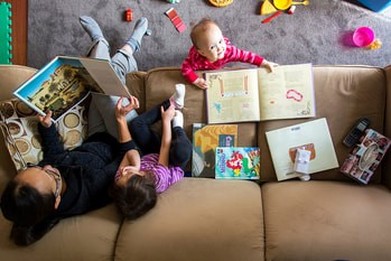
 RSS Feed
RSS Feed
